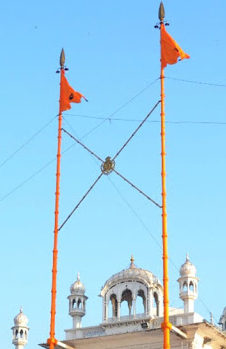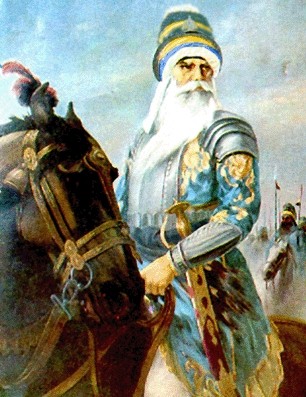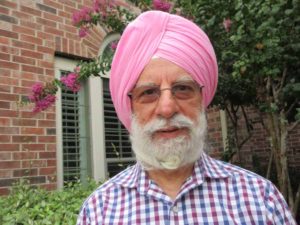Akal Takht: A Journey from Concept to Emerging Digital World
The highest temporal seat of the Sikhs -Akal Takht Sahib, opposite the Darbar Sahib, Amritsar is at the heart of the Sikh religio-political dialogue and its unique status in Sikh theology brings it into the focus of Indo-Sikh relations, especially in the first week of June every year when the Sikhs observe the solemn martyrdom days from 1-6 June. Bhupinder Singh, in this article, traces the origin of Akal Takht Sahib and proposes the use of Internet technologies to adapt the sovereign and democratic Sarbatt Khalsa pattern in creating a virtual mechanism to keep pace with the times, to be fair to the Sikh Diaspora and to meet the challenges of dealing with modern statecraft.
![The highest temporal seat of the Sikhs -Akal Takht Sahib, opposite the Darbar Sahib, Amritsar is at the heart of the Sikh religio-political dialogue and its unique status in Sikh theology brings it into the focus of Indo-Sikh relations, especially in the first week of June every year when the Sikhs observe the solemn martyrdom days from 1-6 June. Bhupinder Singh, in this article, traces the origin of Akal Takht Sahib and proposes the use of Internet technologies to adapt […]](https://www.theworldsikhnews.com/wp-content/uploads/2021/06/Akal-Boonga-360x266.jpg)
AKAL TAKHT IS A 5-storey building in front of Sri Harmandir Sahib or Darbar Sahib, in Amritsar. The building, originally called ‘Akal Bunga’ was built by the Sixth Master -Guru Hargobind Sahib. The word Akal means timeless and Takht is a compound word consisting of Ta + kht, meaning base and line respectively. The word Takht means throne in Persian. Harmandir Sahib became the seat of the spiritual power of the Sikh faith and the Akal Bunga became the central site of its temporal authority. Significantly, the height of the Akal Takht Sahib was deliberately kept less than that of Darbar Sahib.

Inception
Guru Hargobind Sahib laid the foundation of Akal Bunga in 1606, at the open space across the causeway to the Harmandir and completed it in 1609.
A platform of nearly 10 feet, raised on the embankment became the throne for Guru Sahib. The two flags at the Akal Takht Sahib represented the temporal and the spiritual as designed by the Sixth Master. The Piri Nishaan Sahib is hoisted higher, as a reminder of its spiritual eminence.
 In the afternoon, he would meet with followers at the Akal Bunga. It gradually developed into a centre for the resolution of secular affairs and was looked up to as an attractive alternative to the courts of Delhi and Lahore. Guru Ji’s resolution of disputes was fair, fast, and impartial. In the evening, he would go for prayers and singing of hymns, to Harmandir Sahib. At night he and his followers would return to the Akal Bunga, to listen to martial songs of heroic deeds known as “Dhaddi Waran” for which he had appointed bards -Abdula and Natha to narrate songs of valour to inspire and motivate the Sikh Sangat.
In the afternoon, he would meet with followers at the Akal Bunga. It gradually developed into a centre for the resolution of secular affairs and was looked up to as an attractive alternative to the courts of Delhi and Lahore. Guru Ji’s resolution of disputes was fair, fast, and impartial. In the evening, he would go for prayers and singing of hymns, to Harmandir Sahib. At night he and his followers would return to the Akal Bunga, to listen to martial songs of heroic deeds known as “Dhaddi Waran” for which he had appointed bards -Abdula and Natha to narrate songs of valour to inspire and motivate the Sikh Sangat.
Historical Capsule
The first Hukamnamma issued from here by the Guru, asked the Sikhs to bring horses and arms instead of money.
In 1721, five years after the torturous killing of Sikh Generalissimo Banda Singh Bahadur, this Throne of the Immortal, re-emerged as the epicentre. After Banda Singh Bahadur’s execution, the control of Akal Takht was with the Tat Khalsa. A dispute arose between Bandai Khalsa, the followers of Banda Singh Bahadur and Tat Khalsa over the control of Akal Takht. Mata Sundri Ji -wife of Guru Gobind Singh appointed Bhai Mani Singh, as the custodian of Akal Takht and gave him the responsibility of resolving the issues between the two warring factions. Bhai Mani Singh, after deliberations with both the factions, passed the Gurmatta to resolve the issue. Thus the tradition of unanimous Gurmatta was adopted.
 During the Sarbatt Khalsa in 1733, after the offer of assuming Nawabship was spurned by prominent leaders, it was finally offered to Kapur Singh in appreciation of his stupendous spirit of service. It was a challenging time and the survival of the Sikhs was at stake. After deliberations, a consensus emerged under the guidance of a Hukamnamma from Guru Granth Sahib and Nawab Kapur Singh was impressed upon to accept the eminent position. This was a turning point for Sikhs from their existential crisis to becoming masters of their land and destiny. Guided by Gurbani -the Word of the Guru, drawing lessons from history and working through consensus and never functioning unilaterally, he initiated baby steps to the creation of the Commonwealth of the Khalsa.
During the Sarbatt Khalsa in 1733, after the offer of assuming Nawabship was spurned by prominent leaders, it was finally offered to Kapur Singh in appreciation of his stupendous spirit of service. It was a challenging time and the survival of the Sikhs was at stake. After deliberations, a consensus emerged under the guidance of a Hukamnamma from Guru Granth Sahib and Nawab Kapur Singh was impressed upon to accept the eminent position. This was a turning point for Sikhs from their existential crisis to becoming masters of their land and destiny. Guided by Gurbani -the Word of the Guru, drawing lessons from history and working through consensus and never functioning unilaterally, he initiated baby steps to the creation of the Commonwealth of the Khalsa.
 In 1756 Ahmed Shah Durrani attacked India. While returning back from Delhi in 1757, his loot was plundered by Sikhs. Frustrated, he demolished Akal Takht and Darbar Sahib and filled the Sarovar with mud and filth. Following the tradition of building consensus, in November 1760, Sikhs again assembled at a Sarbatt Khalsa before the Akal Takht and declared theirs as the Sikh theo-political voice of the centralized conscious will of the people and a resolution to take possession of Lahore -the seat of Punjab Government.
In 1756 Ahmed Shah Durrani attacked India. While returning back from Delhi in 1757, his loot was plundered by Sikhs. Frustrated, he demolished Akal Takht and Darbar Sahib and filled the Sarovar with mud and filth. Following the tradition of building consensus, in November 1760, Sikhs again assembled at a Sarbatt Khalsa before the Akal Takht and declared theirs as the Sikh theo-political voice of the centralized conscious will of the people and a resolution to take possession of Lahore -the seat of Punjab Government.
Later, even during the rule of Maharaja Ranjit Singh, the autonomy of the Sikh nation over the Darbar Sahib Complex including Akal Takht prevailed. He too was arraigned before Akal Takht Sahib for his misdemeanour.
This arrangement continued from the British Raj in 1850 but was severely marred during the Jallianwala Bagh massacre in 1919, as the British authorities had infiltrated and overtaken SGPC and Akal Takht management with their cronies who manipulated the developments to suit the British.

Not to be undone, the Sikhs rose against that move by starting the Akali movement and the British eventually handed over the possession back to the democratically elected body -Shiromani Gurdwara Parbandhak Committee (SGPC). The formation of SGPC gave a new twist to what constituted Sarbatt Khalsa as the elected body was projected as the representative body of the entire Sikh Brotherhood. This new arrangement changed the way the community decisions were made and the way Jathedars -the provosts of the Akal Takht, were selected.
Changes in Twentieth Century
The wide-ranging events technological and political developments worldwide and within Sikhdom during the twentieth century have had a major impact on the functioning of religious and political affairs of communities and Sikhs too have been greatly influenced.
 To wit, the two World Wars, newer modes of transportation -automobiles, railways, airways, the partition of Punjab at the time of Independence of India in 1947, religious killings and migration of Sikh population from West Punjab to East Punjab and then to the rest of India, the struggle for recognition of Punjab as a linguistic state resulting in the formation of Punjabi Suba and division of East Punjab into 3 states, Indira Gandhi’s Emergency in India in 1975, the killings of Sikhs in Amritsar and Kanpur following the rebuttal of Sikhs of the pseudo-Sikh movement of neo-Nirankaris, the attack on Akal Takht Sahib, Darbar Sahib and 43 other historical Gurudwaras in June 1984 in what was called Operation Bluestar, the egregious human rights violations in Punjab and in India against the Sikhs during Operation Woodrose, the genocidal killings of Sikhs in November 1984 in Delhi and a 100-plus cities across India and the migration of Sikh population to the western countries for survival and search for a good life, are just a small sample of the bludgeoning of the Sikh peoples.
To wit, the two World Wars, newer modes of transportation -automobiles, railways, airways, the partition of Punjab at the time of Independence of India in 1947, religious killings and migration of Sikh population from West Punjab to East Punjab and then to the rest of India, the struggle for recognition of Punjab as a linguistic state resulting in the formation of Punjabi Suba and division of East Punjab into 3 states, Indira Gandhi’s Emergency in India in 1975, the killings of Sikhs in Amritsar and Kanpur following the rebuttal of Sikhs of the pseudo-Sikh movement of neo-Nirankaris, the attack on Akal Takht Sahib, Darbar Sahib and 43 other historical Gurudwaras in June 1984 in what was called Operation Bluestar, the egregious human rights violations in Punjab and in India against the Sikhs during Operation Woodrose, the genocidal killings of Sikhs in November 1984 in Delhi and a 100-plus cities across India and the migration of Sikh population to the western countries for survival and search for a good life, are just a small sample of the bludgeoning of the Sikh peoples.
The view that SGPC is the only representative body of the Sikhs does not now hold true in the fullest sense as it is mandated to manage historical shrines in Punjab including Chandigarh, Haryana and Himachal Pradesh.
As a result of all these events, there has been a significant realignment in the distribution of the Sikh population around the world. The view that SGPC is the only representative body of the Sikhs does not now hold true in the fullest sense as it is mandated to manage historical shrines in Punjab including Chandigarh, Haryana and Himachal Pradesh. It has not been able to that task too in a proper manner and is manoeuvred by political bodies and in its turn manoeuvres the functioning of the Akal Takht is another story.

Emerging Challenges
The ground reality of an emerging Internet and other technologies, including social media, bringing the world technologically closer than ever before and the transmission of information, messages and ideas at the click of a button, a whole new slew of the ground reality of emerging challenges is brewing.
 While the Internet transformed the way we communicate, the Covid19 pandemic rattled religious and political leaders with lockdowns of commercial and religious places of worship and cataclysmic restrictions of travel.
While the Internet transformed the way we communicate, the Covid19 pandemic rattled religious and political leaders with lockdowns of commercial and religious places of worship and cataclysmic restrictions of travel.
Future Possibilities and Relevance
The modern challenge to religion in general and to the Sikhs as a community can be checked and met by aligning the community with a virtually vigorous Akal Takht Sahib. The challenges include staying focused on the issues related to the wider interests of the community at large, and to the cause of freedom that the throne originally espoused.
Virtual meetings and deliberations is a new reality and left with no choice, the world is adopting this at supersonic speed, as it is an unmissable part of our lives.
Against this backdrop or virtual meetings and deliberations, Akal Takht, by adopting a new mechanism has the potential to rope the world Sikh community into collective Panthic decision-making.
Against this backdrop, Sikhs are slowly but steadily reorienting their canvas of discussion and debate. We need to take these nascent efforts and cascade them to a much higher scale to make it a unified voice of the faithful. The clear writing on how things are unfolding is now not on the walls but on the computer screens. The population dispersion and resulting diversity that evolved as a result of migration and conversions into to Sikh faith, along with technical evolutions have made adapting to a new world reality necessary and feasible. This new world reality can enable Sikhs to emerge from the present crossroads, as the Sikhs did in the 1700s.
The Virtual Sarbatt Khalsa at the Akal Takht
If the Sikhs from around the world can make this vision a new reality, then Sikhs would have reasserted the significant role of Akal Takht. The gaps of physical distances have been replaced with virtual connectivity where the work on alignment of thought process, consensus building can take place 24×7 uninterrupted. Now the ideas of the welfare of all –Sarbat da bhala can be shared openly across nations, nationalities, time zones, with comparatively fewer censorship restraints and political controls.
 The computer screen is going to become a glue to join the faithful or to unleash schism. This quantum jump can transform the existing lack of faith along with feelings of disillusionment in the institution that can be rectified. The Akal Takht can reemerge as the epicentre of Sikh affairs and may even enable to develop a virtual Sarbatt Khalsa to select and anoint a committed but reluctant Nawab Kapur Singh as the universally acceptable visionary Jathedar of Akal Takht.
The computer screen is going to become a glue to join the faithful or to unleash schism. This quantum jump can transform the existing lack of faith along with feelings of disillusionment in the institution that can be rectified. The Akal Takht can reemerge as the epicentre of Sikh affairs and may even enable to develop a virtual Sarbatt Khalsa to select and anoint a committed but reluctant Nawab Kapur Singh as the universally acceptable visionary Jathedar of Akal Takht.
References:
- Singh, Teja & Singh, Ganda. A Short History of Sikhs. Punjabi University, Patiala (1994)
- Singh, Dr. Santokh. The Guru’s Word & Illustrated Sikh History. Spiritual Awakening Studies, Princeton, ON (2000)
- Singh, Kapur. The Golden Temple: Its Theo-Political Status. Dharam Parchar Committee (1995)
- Dilgeer, Harjinder Singh, The Akal Takht. Punjabi Book Company (1980)
- Gandhi, Surjit Singh. History of the Sikh Gurus (A Comprehensive Study). Gur Das Kapur and Sons, Delhi (1978)
Title Photo Courtesy: Akaal Boonga Painting by Simpson & William, Victoria & Albert Museum, London
 Hailing from Myanmar, educated in India, Bhupinder Singh is an engineer by profession, doing business in Houston, USA, with a keen interest in writing books and articles on Sikh history, motivation and spirituality.
Hailing from Myanmar, educated in India, Bhupinder Singh is an engineer by profession, doing business in Houston, USA, with a keen interest in writing books and articles on Sikh history, motivation and spirituality.
